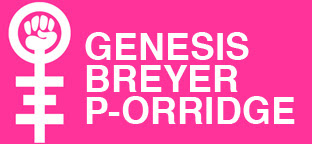genesis breyer p-orridge

Genesis BREYER P-ORRIDGE is a true legend of the Anglo-American underground, an avant-garde anti-hero whose remarkable body of work reminds us that what is dangerous and what is important are never far apart—
and that, when you believe something, artistic integrity demands that you live by it too.
P-Orridge first achieved recognition with the 1969 founding of COUM Transmissions, a confrontational performance collective heavily influenced by Dada, which was later transformed into the band Throbbing Gristle. (P-Orridge would, in 1981, found the ground-breaking band, Psychic TV.) By the time COUM disbanded in 1976, it had helped push the boundaries and shatter the definitions of performance and contemporary art, paving the way for later transgressive work. The culmination of COUM was the 1976 “Prostitution” exhibition at the ICA in London, which featured a stripper, used Tampax sculptures, repurposed pornography and transvestite guards, and caused such a commotion that the British Parliament reconsidered government funding for public art and labeled P-Orridge and h/er collaborators “Wreckers of Civilization”.
In the early 1970s, P-Orridge met William S. Burroughs, who introduced h/er to Brion Gysin, marking the beginning of a seminal and influential collaborative relationship. Burroughs, under Gysin’s tutelage, repopularized the “cut-up”
technique of the early 20th century Surrealists, in which text, or narrative imagery, is cut up and re-organized, creating a new, non-linear formulation. The supremely Dadaist practice would influence P-Orridge throughout h/er career and remains an integral element of h/er work.
P-Orridge was an early participator in Fluxus and Mail Art, applying the theories of John Cage (upon which the foundations of Fluxus are built) on the pressed recording “Early Worm” in 1968, and exchanging works with Ray Johnson among others. Responding to P-Orridge’s Mail Art, the British General Post Office charged h/er in 1976 with sending “indecent and offensive material” through the mail, including desecrated images of the Queen. Like many artists at this time, P-Orridge rejected market-driven work, choosing instead to maintain an artist-centered creative nucleus in which work was shared within a community, and was never intended to enter the commercialized art world. P-Orridge later began an occultist practice influenced by the theories of the artist Austin Osman Spare. The “sigils” they performed explored the relationship between the conscious and unconscious self through magical techniques such as automatic writing, drawing and actions, relics of which can be found in many of P-Orridge’s collage work.
In the 1990s, P-Orridge began a collaboration with the performance artist Lady Jaye Breyer, which focused on a single, central concern—deconstructing the fiction of self. Influenced again by “cut-up” techniques and frustrated by what they felt to be imposed limits on personal and expressive identity and on the language of true love, P-Orridge and Lady Jaye applied the strategy of “cutting-up” to their own bodies, in an effort to merge their two identities, through plastic surgery, hormone therapy, cross-dressing and altered behavior, into a single, “pandrogynous” character, “BREYER P-ORRIDGE".
They embraced a painterly, gestural approach to their own bodies, making expressive and startling use of signifiers like eyebrows, lips, and breasts, in order to resemble one another as much as possible. The work was an exercise in elective, creative identity, and a test of how fully two people could integrate their own lives, bodies, and consciousnesses, a symbolic gesture towards evolution and true union. Although Lady Jaye passed away in 2007, the project continues with Genesis embodying the entirety of BREYER P-ORRIDGE.
Genesis P-Orridge and BREYER P-ORRIDGE have exhibited internationally, including recent exhibitions at Deitch Projects, Mass MOCA, Centre Pompidou, Contemporary Art Museum St. Louis, Barbican Museum, the Swiss Institute and White Columns, amongst others. Work was recently acquired for the permanent collection of the Tate Britain.
vea y oiga el trabajo de genesis aqui: http://www.genesisbreyerporridge.com/homepage.html

Comentarios
Publicar un comentario
Reacciona a esta publicación. Déjanos saber tus impresiones.